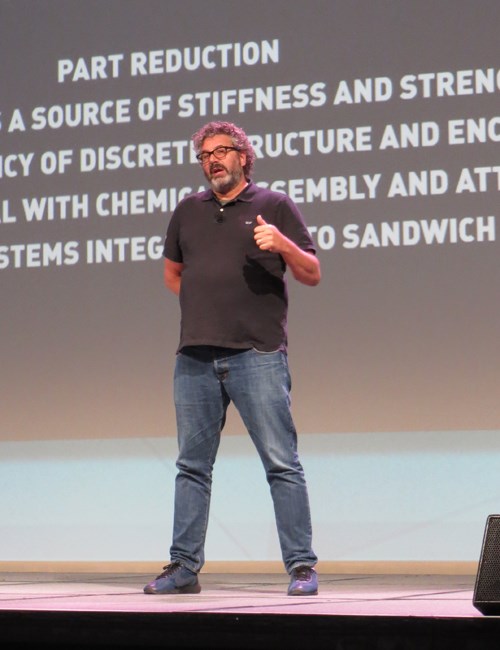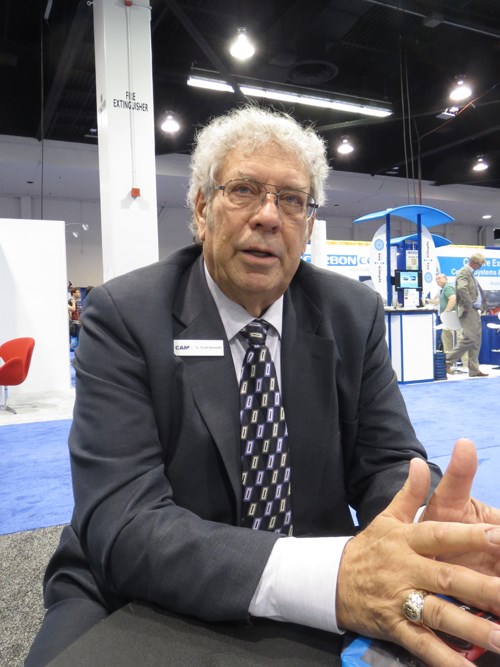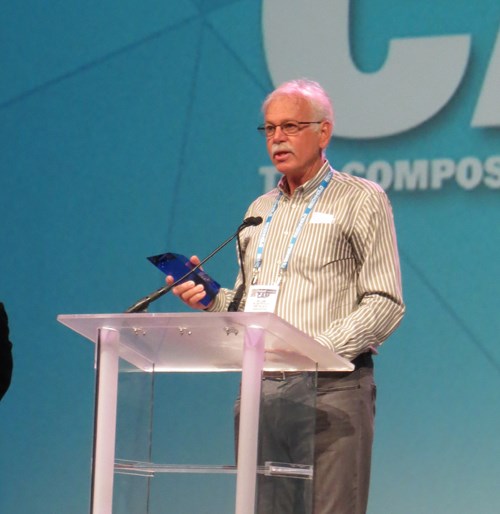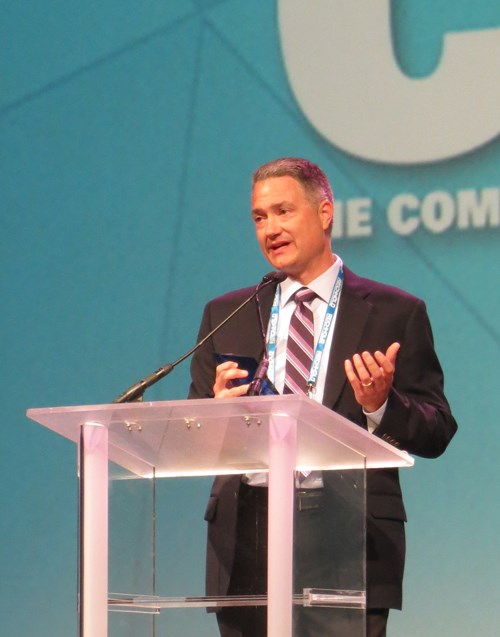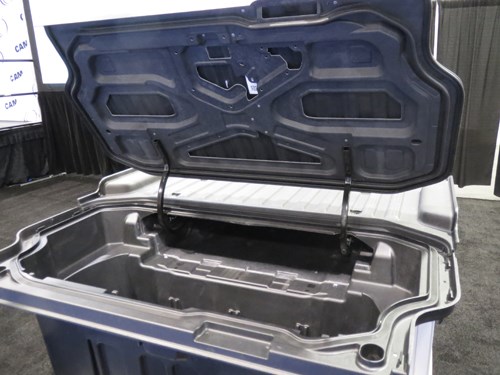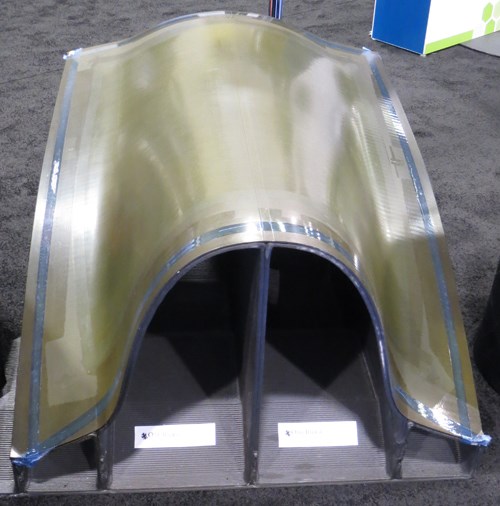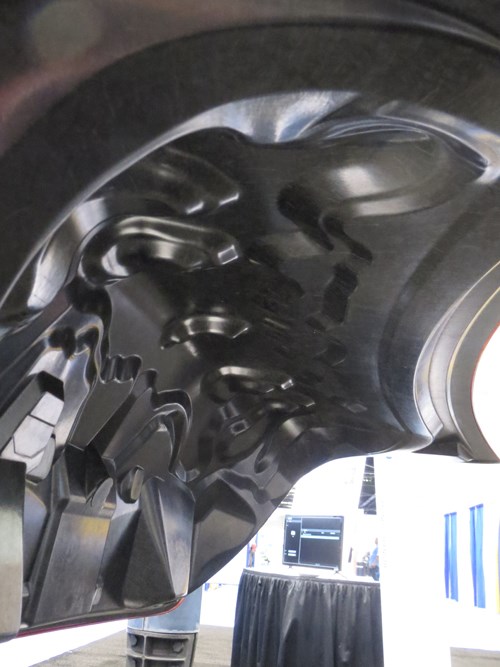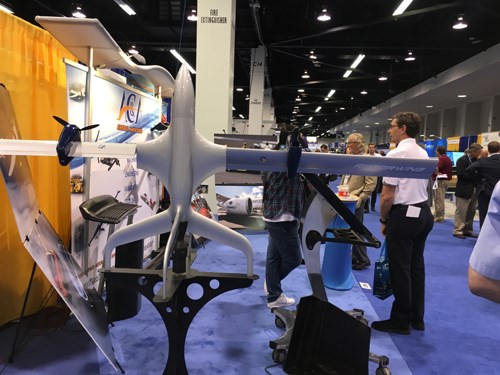CAMX 2016: The final report
With CAMX 2016 quickly receding, we offer this the full, complete and final report on what was seen, what was heard and what was new at North America's largest composites industry event. And we hope to see you next year at CAMX 2017, Sept. 11-14 in Orlando, Florida.
With CAMX 2016 quickly receding, we offer this the full, complete and final report on what was seen, what was heard and what was new at North America's largest composites industry event. And we hope to see you next year at CAMX 2017, Sept. 11-14 in Orlando, Florida.
In three short years, the Composites and Advanced Materials Expo (CAMX) has evolved into the largest composites event in North America, the composites industry’s largest market. CAMX officially kicked off on Sept. 27 with a General Session that featured three creative and visionary keynote speakers who have applied composites in new and compelling ways that promise to change how we think about communication, transportation and architecture. About 1,700 showgoers filled the hall to hear testimony to composites’ high utility as a problem-solving material.
Visionaries frame new futures
First up was Daniel Preston, CEO and CTO of Luminati Aerospace (Calverton, NY, US), a new company dedicated to bringing Internet connectivity to all areas of the world. He and his team are developing, among many products and technologies, high-altitude, long-endurance (HALE) unmanned vehicles that will harvest energy from wind and sun to stay aloft. These vehicles will be constructed by automated layup methods, using carbon fiber composites supplied by Hexcel (Stamford, CT, US).
Due to a scheduling conflict, Preston could not attend CAMX in person, but appeared via video. He commented on his early success as a student (college at age 12, graduated in his teens) and in business (sold his first business and “retired” in his 20s), and how that led, eventually, to the HALE effort, which was prompted by a “large dot-com” that was seeking to provide Internet access to underserved regions around the world. The result is the V0-Substrata, a solar- and wind-powered, pilot-optional, composite aircraft that, Luminati hopes, will be doing HALE-based work soon.
Next up was Gregory Haye, general manager at Local Motors (Knoxville, TN, US), who is overseeing his company’s development of vehicles built from advanced materials via large-format additive manufacturing methods with a goal of reducing impact on the environment.
Haye walked session attendees through the implications of Local Motors’ “strive for less” mantra, the goal of which is to rethink the motor vehicle design and development paradigm. Or, as Haye put it, “The vehicle as we know it must die.” Haye emphasized Local Motors’ desire to condense the vehicle development process with digital-based tools that enable fast toolmaking and direct manufacturing — processes done via additive manufacturing technology; specifically, Cincinnati Inc.’s (Cincinnati, Ohio) Big Area Additive Manufacturing (BAAM) machine, which uses a chopped carbon fiber-reinforced ABS. Haye also discussed Local Motors’ work developing — in only three months — Olli, a composites-intensive, multi-passenger, autonomous mini-bus designed for urban mass-transit.
Wrapping up was Greg Lynn, owner of Greg Lynn FORM (Los Angeles, CA, US). At the forefront of fresh, functional and unusual structural design with composite materials, Lynn is one of the 10 most in influential architects living today, according to Forbes magazine.
Like Preston and Haye, Lynn is highly motivated to build new paradigms based on the application of composites. In architecture, he noted, composites offer moldability and adaptability not possible with steel and aluminum. As a result, curved weight-bearing structures have become possible, bringing new dynamism to home and building design. The challenge, he said, is that many architects and designers are stuck in a paradigm that relies on legacy materials, and they are trying to adapt composites to fit into that mindset. “If you think about composite beams like you think about steel beams, it’s a mistake,” he said, adding, “In fact, if you think about composite beams at all, you’re lost.” Lynn’s work, however, does not stop at building and construction. He’s also experimenting with composites in boat design and manufacture, and he is working with sports teams on innovative composite-based structures designed to help athletes better understand how their bodies perform under certain conditions, and to help them recover from injuries more quickly.
SAMPE distinguished service
Composites industry veteran and longtime SAMPE member and activist Scott Beckwith received the inaugural Distinguished Service Award from SAMPE for his service to the organization and the composites industry. The award came a “complete and total surprise” to Beckwith, who said that he was overwhelmed by the honor.
Beckwith owns his own consulting firm, BTG Composites (Taylorsville, UT, US), and has been SAMPE’s technical director since 1998, making him the longest serving person on SAMPE’s executive board.
He says he joined SAMPE in 1974 when he got a job at Hercules in Salt Lake City, UT US. Beckwith’s boss was a past-president of SAMPE and suggested Beckwith get involved. “Membership was just $26 a year and I thought that was a pretty good deal,” he says. “Before I knew it, I was writing papers and giving presentations.” And he hasn’t looked back.
Beckwith worked at Hercules through 1993, and then launched BTG Composites, which offers consulting, expert testimony, design, training, process development and a variety of other services. Beckwith’s most memorable product development project? The Vomit Comet, a composite structure with four rows of four seats into which NASA strapped astronauts-in-training, and then rotated them, amusement park-style, at speeds up to 70 rpm. “It had to be fully cleanable,” Beckwith quips.
Looking to composites’ future, Beckwith is cautiously optimistic about growth and technical development. What he hopes to see more of, however, is technological cross-pollination, particularly between aerospace and automotive, the latter of which has substantial cycle time, quality and process control problems to solve: “I am hoping that, as they meet those challenges and find solutions, the aerospace industry will adapt some of the same technology.”
Beckwith also points to workforce development — particularly among high school and young college students — as vital to the composites industry’s expansion and maturation, and he is glad to see SAMPE and ACMA both heavily involved in education and training.
CAMX Awards
The winners of the annual Combined Strength, Unsurpassed Innovation CAMX Awards were announced at the CAMX 2016 General Session, and the prize-winning products hail from the fast-developing automotive and the architectural end-markets.
The winner in the Combined Strength category was the "Multi-Material Decklid Concept," submitted by Continental Structural Plastics (CSP, Auburn Hills, MI, US). The decklid, featuring a trademarked TCA Ultra Lite sheet molding compound (SMC) outer and a carbon fiber resin transfer molded (RTM) inner, weighs only 5.5 kg, representing a 13% weight savings over a similar aluminum decklid. The SMC decklid was developed in collaboration with Owens Corning (Toledo, OH, US), Compose Tooling Expert (Bellignat, France), Altair Engineering (Troy, MI, US), PPE (Pole de Plasturgie de L'Est, Saint Avold, France), Hexion (Columbus, OH, US) and Brandolph Srl (Castello di Godego, Italy).
When he received the award, CSP’s R&D director Mike Siwajek acknowledged that the material and process technologies in the decklid are not, technically, new, but emphasized that they have been combined in new ways to meet unique challenges. “By marrying all these technologies and making something old new again,” he contended, “we have a chance to really make an impact in the automotive industry.”
In the Unsurpassed Innovation category, the CAMX Award winner was "Fire-Resistant FRP Façade Cladding System for High-Rise Building,” submitted by Kreysler & Associates (American Canyon, CA, US). The cladding system, applied to the recent San Francisco Museum of Modern Art (SFMOMA, San Francisco, CA) expansion, marks the largest architectural use of fiber-reinforced plastic (FRP), to date, in a US building project. It required more than 700 panels, some as large as 1.5m wide by 9m long, totaling 7804m2 on a contoured 10-story façade, and was the first composite system to pass rigorous fire regulation testing for use above the fourth story.
Company president accepted the award but was quick to acknowledge his employees who share the honor by having helped make the SFMOMA façade a reality. Kreysler also implored the audience to help accelerate composites development and application by getting involved with either ACMA or SAMPE. “You will make this organization stronger if you volunteer,” he said. “I always felt like I got more than I gave.”
Awards for Composites Excellence
ACMA also made its ACE (Awards for Composites Excellence) presentations in the pavilion by the same name on the CAMX show floor. ACE has recognized outstanding achievement and innovation in the categories of design, manufacturing and market growth/product development for more than 20 years. That tradition continued with the following announcements.
The winner in the Design category, Most Creative Application, is "Pultruded FRP Replaces Aluminum for the Silver Flow," submitted by Strongwell (Bristol, VA, US), for an eye-catching car show display created for Mercedes. In the Manufacturing category, Material and Process Innovation, Oak Ridge National Laboratory (ORNL, Knoxville, TN, US) was selected for its "3D Printing of High-Temperature Thermoplastic Molds." Elsewhere in the same category, T Plates Global LLC (Oceanside, CA, US) was a winner for Most Creative Application for its customizable thermoplastic sandwich core. Thermoplastic injection molded cells have an open architecture with strength in compression and shear and are welded (on one or both sides) to a 25 g/m2 non-woven glass veil with random chopped fibers, suitable for large area applications such as wind turbine blades.
In the Manufacturing category, Equipment and Tooling Innovation Award, "Innovative Robotized Preform Cell Providing 3D Stacking and Control" was the winner, submitted by Composite Alliance Corp. (Dallas, TX, US). And finally, in the Market Growth category, Infinite Possibility for Market Growth, the winner is the "2017 Honda Ridgeline Weatherable SMC Truck Bed," submitted by Ashland Performance Materials (Columbus, OH, US).
California’s Proposition 65
Of special interest to composites manufacturers selling to customers in California—and potentially elsewhere — was a panel session on California’s Proposition 65, specifically, its classification of styrene as a carcinogen. Prop 65 considers that composite products made using polyester or vinyl ester resins will contain some amount of residual styrene that would or could expose users of that product to some level of styrene. It encompasses a requirement that warning must be given if the manufacturer makes or uses a regulated chemical (including styrene and styrene oxide) in California. Failure-to-warn suits can be brought against manufacturers of styrene-containing products beginning 2017, carrying a $2,500 penalty (and attorney fees). The plaintiff need not show harm has been done. The burden is on the corporation if it has not provided warning.
The panel was led by John Schweitzer, special advisor to the president of ACMA, who assured the industry that ACMA is working on this. He strongly recommends that composites manufacturers “should start preparing a plan.” (See www.acmanet.org/prop65 for detailed guidelines.)
OOA innovation
In manufacturing and processing technologies, two technical presentations and a panel session featured out-of-autoclave (OOA) innovations — a relatively new trend with potential for aerospace-quality parts at lower cost. Demonstration of an inflatable, collapsible pressure intensifier for out-of-autoclave composite processing using BMI prepreg won an Outstanding Technical Paper Award. Steven Scarborough of ILC Dover (Frederica, DE, US) was the primary author and presenter; Steve Slaughter and Jason Varnum of Scaled Composites (Mojave, CA, US) were co-authors.
ILC originally built the pressure intensifier for the US Department of Homeland Security as a 5.18m-diameter inflatable pressure tunnel for containing breathable air while sealed against poisonous gasses. Slaughter said he sees it, instead, as a big oven for curing composites. Scaled Composites has built all its aircraft without an autoclave — including the all-composite Voyager, which flew around the world nonstop in 1984, and SpaceShipOne, which won the Ansari XPRIZE in 2004.
Scaled fabricated 40.6-cm by 50.8-cm composite panels for cure at 15 psig pressure inside the pressure intensifier using Toray T400-800 carbon fire with Solvay’s Cycom 5250-4HT BMI prepreg and AGY 6781 S2 fiberglass with 5250-4 BMI prepreg systems. BMI resin was selected because it is more difficult to process by OOA than epoxy. The project produced an aerospace-grade laminate, i.e., <1% voids. Proposed applications include in-field aircraft repair and manufacture of wind blades.
Kara Storage, Air Force Research Laboratory (Wright-Patterson AFB, OH, US) moderated a Featured Session panel that considered OOA applications and their potential impact on future growth. Panelists were Jim Martin (Globe Machine Manufacturing, (Tacoma, WA, US); Randy Johnsen (Solvay, Tempe, AZ, US); Doug Decker (Northrop Grumman, Falls Church, VA, US); Sean Johnson (TenCate Advanced Composites, Morgan Hills, CA, US); and Timotei Centea (M.C. Gill Composites Center, University of Southern California, San Diego, CA, US). Panelists agreed that new material systems need to be developed with good out-life and stability for OOA, and suitable for nondestructive inspection. Solvay and other suppliers are working on new resins and other materials targeted for OOA. The process is seen as an enabler for bonded structures, but some panelists suggested it might not be ready for large-aircraft manufacture.
Pilar Lopez (Airbus, Toulouse, France) presented her work in bonding primary and secondary structures on OOA bonded repairs for the A350 XWB. With a goal of certified OOA structural bonding repair solutions, she researched co-bonding possibilities using either dedicated repair materials or original product materials, with repair work done in portable cleanrooms or portable inflatable tent hangers. Two material grades have been qualified and tests showed that bonded repairs can be successful.
Bubbles
3M (St. Paul, MN, US) featured a host of new developments for composites, including microsphere nano-particles (called bubbles), from its Aerospace and Commercial Transportation division, that can be mixed with resin in molds, displacing resin with air, but with no loss in properties — and, even more importantly, the technology to disperse the microspheres uniformly and homogeneously. The bubbles are compatible with custom and standard epoxies, phenolics, BMIs and vinyl esters and offer potentially lower cost in a wide range of applications, from driveshafts to sporting goods. 3M’s Tapes and Adhesives division has developed new nonsilicone, high-temperature polyester disposable tapes and a urethane multi-material composite adhesive that will bond composites to composites or composites to metal. An online composite bonding selector is new on 3M’s Web site, and 3M will test the adhesive for the application, free of charge. 3M’s Advanced Materials featured its Nextel ceramic fibers DF-11 series, said to be the next generation ceramic fabrics at lower cost; one application is a high denier flame barrier for aircraft.
Bio-resin market growing
Sicomin (Marseille, France) presented its range of epoxy resins with a bio-based carbon content ranging from 28-51%, which can be used in hand lamination, infusion, pultrusion/filament winding and HP-RTM processes. Sports equipment providers, from skis to surfboards, are pushing for bio-based products, says Sicomin's export manager Marc Denjean. Sicomin’s bio-resin GreenPoxy33, for example, is being used to mold French ski manufacturer ZAG's extra-light touring ski range. And while several European companies have worked with the company to produce bio-friendly products, Marc Denjean says Sicomin also is seeing demand from North American companies for the bio-resins in the sports and leisure market.
Automotive crash analysis
Altair (Troy, MI, US) emphasized its tools and expertise for analyzing and optimizing composite structures. The company provides impact analysis for high-momentum events — bird strikes, crash impacts, drops and more — using its RADIOSS structural analysis solver. RADIOSS’ applications include not only crash safety, drop and blast and hydrodynamic impact testing but also terminal ballistic fluid structural interaction, forming and composite mapping. Robert Yancey, Altair’s VP of aerospace, told CW that the company is using its 20-plus years of aerospace experience to focus on automotive crash analysis to improve crashworthiness, safety and manufacturability of structural designs.
Bow and arrows
Hollywood has rejuvenated interest in archery thanks to the NetFlix TV show Arrow, and the four Hunger Game movies. Composites are also making their mark in the archery industry, where Huntsman Advanced Materials (The Woodlands, TX, US) had a display of a Hoyt compound bow and Easton composite arrows. So imagine a 1.2lb hollow carbon riser surviving being run over by a 6,115-lb full-sized truck — apparently that’s the strength of Hoyt’s carbon technology bows. More than 50 custom carbon components went into making this bow. And on the arrow side, Easton composite arrows feature a unidirectional carbon fiber core and micro-smooth finish for quiet release and “easier removal from targets.”
Polyamides for aircraft interiors
Solvay (Brussels, Belgium) announced at CAMX 2016 that its Ixef BM-1524 polyarylamide (PARA) is now qualified to the Boeing BMS 8-270 standard governing polyamides for aircraft interiors. This new listing expands opportunities for lightweighting through metal replacement for designers of aircraft interior components, and offers a more cost-effective, easily processed and structurally superior alternative to conventional plastics such as polyetherimide (PEI).
Armin Klesing, global business development manager for aerospace at Solvay’s Specialty Polymers business unit, says the newly listed product’s “unique mechanical and processing performance offers broader design latitudes for a wide range of aircraft interior components, which helped make its certification a priority for Boeing. Today, Ixef PARA is well-positioned to become the material of choice for commercial aircraft interior applications where cost-effective light-weighting is a key driver in polymer specification.”
A 50% glass-fiber reinforced, semi-crystalline, semi-aromatic polyamide, the natural-colored, halogen-free flame retardant (HFFR) polymer delivers metal-like strength and stiffness, making it an option for lightweight fasteners, attachments and brackets. Ixef BM-1524 PARA meets Federal Aviation Admin. (FAA) 60-second vertical burn requirements per 14 CFR 25.853 Appendix F, as well as toxic gas emission requirements under BSS7239 and ABD0031.
Reichhold + Polynt
As CAMX commenced, Resins suppliers Reichhold (Research Triangle Park, NC, US) and Polynt Composites (Carpentersville, IL, US) were in the midst of consummating a 50/50 merger that will, when complete, mark a substantial change in the composites industry's resin supply chain.
Dale M. MacDonald, VP commercial, North America, at Reichhold, told CW that the merger has been approved by American regulatory authorities, but that European Union authorities were still reviewing the deal. The hope, he said, is that it would be approved by year’s end.
Until then, how the merged companies might present themselves to the market remains to be seen. MacDonald says it’s undecided what will become of the Reichhold and Polynt names post-merger, but he did point out that the former celebrates its 90th anniversary in 2017.
Reichhold is owned by Black Diamond Capital Management LLC. Polynt is owned by Investindustrial. If the merger is approved, each company will have a 50% share, with management provided by a six-person board.
On the composites process side of the business, MacDonald said it’s business as usual and noted that Reichhold is working right now, in cooperation with the Institute for Advanced Composites Manufacturing Innovation (IACMI, Knoxville, TN, US), to apply its Advalite vinyl hybrid monomer-free resin to automotive structures. It offers, he said, a cure time of 45-60 seconds and a Tg of 150°C, which makes it suitable for the electrophoretic (E-Coat) painting process.
Educational partnership
Composites One (Arlington Heights, IL, US) and Davis Applied Technology College (DATC; Kaysville, UT, US) announced an educational partnership designed to provide students with the skills needed for a successful career in the composites industry by helping students explore advanced composites, including prepreg, thermoplastics, out-of-autoclave processing and additive manufacturing.
“Composites One is dedicated to the advancement of our industry,” said Composites One president and COO Leon Garoufalis. “With this new partnership, we can help prepare the next generation of composites professionals, as well as ensure that more of our industry’s existing workforce is educated on the latest composites technologies.”
Joining Garoufalis at the event was DATC president Michael Bouwhuis, and Ben Hart, managing director – Urban and Rural Business Services in the Utah Governor’s Office of Economic Development.
“This partnership with Composites One is very exciting,” said Bouwhuis. “Where education and industry can come together with a common cause is always a productive partnership. Together we will help to prepare highly skilled workers to preserve global competitiveness and economic opportunity within the composites industry. We will also ensure that there is a future workforce for this growing industry.”
Cure sensors
AvPro Inc. (Norman, OK, US) has partnered with TSI Technologies LLC (Wichita, KS, US) to develop the next generation of composite cure temperature sensors, called the ThermoPulse system. Consisting of an antenna with transmit and receive capabilities, an embeddable microwire temperature sensor and a reader box, which collects the antenna readings, the ThermoPulse in-situ measurement system allows for wireless monitoring of temperature from the interior of a composite part, bondline or repair.
Measuring just 0.25 mm by 32 mm, ThermoPulse sensors are small enough to be permanently embedded in fly-away parts. Studies with American and European companies showed no significant difference in mechanical properties between samples created with sensors and those without.
Throughout cure, the ThermoPulse Microwire supplies real-time temperature data to the controller, providing assurance and log records that performance-critical parts are actually reaching required temperatures. ThermoPulse can facilitate AvPro's Material State Management (MSM) solution for composites processing which helps provide critical visibility re: the degree of cure and the effects of a cure process on the part itself. (For more background, see “Automation and optimizing autoclave cure”.)
On a similar subject, Christian Weimer, head of Domain Composite Materials & Process for Airbus Group Innovations (Munich, Germany), gave a presentation on Sept. 29, titled “Increasing the Productivity of CFRP Production Processes.” Speaking mainly through the lens of increasing predictability and reliability, Weimer discussed current issues and future needs in composite aerostructures production. He then announced that Airbus has spun off a new subsidiary, InFactory Solutions (Ottobrunn, Germany), that will develop, qualify and deliver sensor systems, data analytics and engineering consulting services for more automated, connected and intelligent manufacturing.
InFactory’s first commercialization is a sensor for quality monitoring during automated fiber placement (AFP) of composite structures that reduces inspection time by >95%. The sensor can be used on any AFP head (e.g. AFPT, Coriolis, Electroimpact, Fives, Ingersoll, MTorres) and is qualified per Airbus Process Spec (AIPS).
The system is already being tested for A350 XWB production at the Airbus plant in Illescas, Spain. Sites in Germany, Airbus Group Helicopters in Donauworth and Premium Aerotec in Augsburg, will follow by year’s end. InFactory Solutions will offer its products and services to suppliers worldwide and aims to develop solutions for the complete composites process chain, including other layup methods, curing, machining, etc.
Backpack frame
Other highlights included a compression-molded C-PLYT backpack frame developed by Rocket Composites (West Sacramento, CA, US) and Chomarat (Le Cheylard, France and Williamston, SC, US). Compared to previous models made from traditional woven carbon fabrics, the new frame is 25% stronger with much better torsional stability. “We were hitting limitations with traditional woven materials,” explains Rocket Composites CEO Paul Hewitt. “We had started looking into spread-tow materials, but this triaxial provided the longitudinal strength and stiffness and torsional stiffness we needed.” The frame is a sandwich of C-PLY triaxial on either side of a foam core, compression molded using epoxy resin from Entropy Resins (Hayward, CA, US) in a 20-minute cycle. It may look familiar, having been featured in the before-and-after recycling image in the January 2016 issue’s CW Ideas in Action column and CAMX 2015 highlights.
Recycling collaboration
Connora Technologies (Hayward, CA, US) and Adesso Advanced Materials (Wuxi, Jiangsu Province, China and Monmouth Junction, NJ, US) have taken further steps in advancing their recyclable epoxy technology. Connora exhibited its Zero-landfill Manufacturing Project with Burton Snowboards (Burlington, VT, US) and the world’s first recyclable surfboard. The project involves not only recovering fiber but converting reclaimed thermoset epoxy into a thermoplastic, which is then reused in snowboard bindings and surfboard fins. Meanwhile, Adesso displayed printed circuit boards that are similarly recyclable, addressing a huge issue for the electronics industry, as well as programs with composite bicycle manufacturers and electric bus suppliers/operators.
COUNTERVAIL in a racket
Materials Sciences Corp. (MSC, Horsham, PA and Greenville, SC, US) and Wilson Sporting Goods (Chicago, IL, US) have entered into an exclusive agreement to explore and develop applications of MSC’s COUNTERVAIL vibration-dampening composite technology. MSC is exhibiting the 2017 Serena Williams Blade SW 104 Autograph racket, which uses COUNTERVAIL to reduce vibration energy, helping players experience better control and less fatigue, without sacrificing light weight, stiffness or feel.
Exhibition quick takes
- Compotool (Monroe, WA, US) high-temperature tooling materials and ceramic tooling board that can be vacuum bagged and autoclave cured, and report significantly reduced manufacturing time.
- Dexmet (Wallingford, CT, US) lightning strike foils thinned down to 0.001-0.002 inch from existing 0.003-0.0005 inch.
- Evonik Foams Inc. (Theodore, AL, US) PMI Triple F Rohacell foam cores for carbon composite products—a closed cell, high-temperature resistant structural material developed primarily for automotive products and found in some Lamborghini models.
- McClean Anderson (Schofield, WI, US) featured its new Pattern Master III entry-level software controls for axial and off-axial filament winding, for mass manufacturing of pipes.
- Mistras Group (Princeton Junction, NJ, US) showing NDI equipment for water-immersion or air-coupled, through-transmission inspection, plus passive acoustic emissions systems for infrastructure and aerospace.
- NDT Solutions Inc. (New Richmond, WI, US) partnered with a tier one supplier manufacturing composite hat-section stringer-stiffeners for wing skins. NDT pulse echo ultrasonic inspection allows 100% inspection, in two passes, of the top, sides and radius of the composite cured stringer.
- Quatro Composites (Orange City, IA, US) featured QFORGE chopped carbon/PPS with 0.5-inch to 1-inch long fiber in a proprietary thermoplastics molding process, said to be 30-40% lighter than aluminum at a similar cost.
- Sigmatex (Benicia, CA, US), introduced 3D fabrics having no seams, joints or overlaps—a single piece woven fabric in x, y, z directions that can be custom-preformed by CAD design in fiber architecture for near-net shape by matched die molding, RTM or RIM. It has also added spread-tow fabrics for automotive and sporting goods. Additionally, new, recycled fabrics made from the waste streams of carbon fiber, which can be aligned with thermoplastics into new fabric. The result is said to be similar in level to virgin-grade fabric with thermoplastic blend. Main market is automotive.
Millennial insights
CAMX 2016 concluded with a luncheon featuring a panel of students who offered their insights on how advances in composites are changing the world. The topics varied from recycling to diversity.
Kristin Hardin, a Ph.D student at The University of Alabama at Birmingham (UAB), said that while composites have become widespread and used for incredible things, there is even greater potential for the industry moving forward if businesses embrace sustainability. “I really like an environment that fosters creativity from the bottom up as well as from the top down, and also an employer that promotes education and growth for their employees through education programs and further education opportunities,” she said. “I’d also like to see an employer that promotes diversity.”
Related Content
ASCEND program update: Designing next-gen, high-rate auto and aerospace composites
GKN Aerospace, McLaren Automotive and U.K.-based partners share goals and progress aiming at high-rate, Industry 4.0-enabled, sustainable materials and processes.
Read MoreNatural fiber composites: Growing to fit sustainability needs
Led by global and industry-wide sustainability goals, commercial interest in flax and hemp fiber-reinforced composites grows into higher-performance, higher-volume applications.
Read MoreHexagon Purus Westminster: Experience, growth, new developments in hydrogen storage
Hexagon Purus scales production of Type 4 composite tanks, discusses growth, recyclability, sensors and carbon fiber supply and sustainability.
Read MoreWatch: A practical view of sustainability in composites product development
Markus Beer of Forward Engineering addresses definitions of sustainability, how to approach sustainability goals, the role of life cycle analysis (LCA) and social, environmental and governmental driving forces. Watch his “CW Tech Days: Sustainability” presentation.
Read MoreRead Next
VIDEO: High-volume processing for fiberglass components
Cannon Ergos, a company specializing in high-ton presses and equipment for composites fabrication and plastics processing, displayed automotive and industrial components at CAMX 2024.
Read MoreAll-recycled, needle-punched nonwoven CFRP slashes carbon footprint of Formula 2 seat
Dallara and Tenowo collaborate to produce a race-ready Formula 2 seat using recycled carbon fiber, reducing CO2 emissions by 97.5% compared to virgin materials.
Read MoreDeveloping bonded composite repair for ships, offshore units
Bureau Veritas and industry partners issue guidelines and pave the way for certification via StrengthBond Offshore project.
Read More


